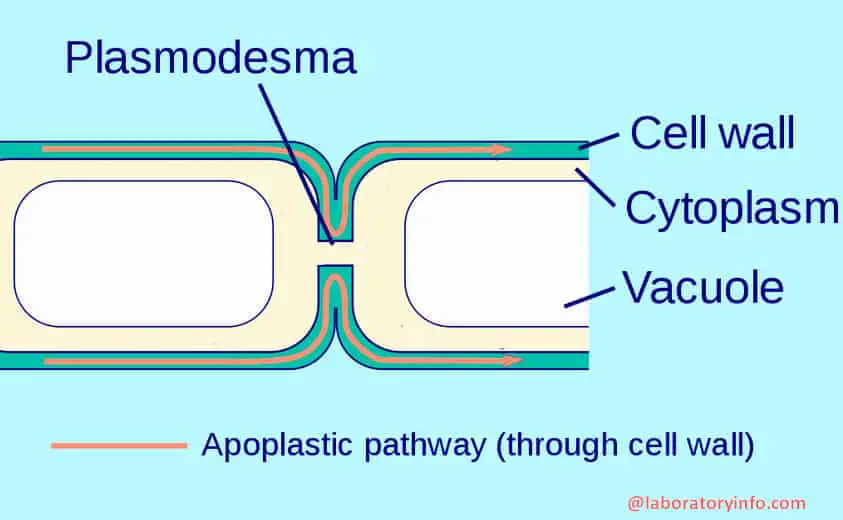Apoplast and symplast are two pathways used by water to travel from the root hair cells to the xylem of the root. They are very much the same but they too differ in many ways.
The difference, as well as the similarities between Apoplast and symplast will be discussed in this article. (1, 2)

(The apoplastic pathway and the symplastic pathway as shown in the diagram above)
Apoplast
It pertains to the non-protoplasmic spaces of plants. It consists of the cell wall and intracellular spaces. In the root cortex, Apoplast is used to move the water to the xylem and then absorbed by the root hair cells.
The direction is called the apoplastic pathway. It does not have the ability to cross cytoplasmic membranes, which causes the water to move through passive diffusion. In other words, it is least resistant to the movement of water. (1, 2, and 3)

(The apoplastic pathway as explained in the above image.)
Symplast
It pertains to the protoplasmic part of the plant. The cell’s protoplasm is connected by plasmodesmata; a cell junction.

(The Symplast is the inner part of the plasma membrane that enables the water and solute to diffuse freely.
What is the use of the symplast of the root cortex?
It is significant for moving water from the root hair cells to the root’s xylem. The direction by which the water moves is known as the symplastic pathway.
In the said pathway, the water moves in the cell’s cytoplasm through the plasma membrane enabling it to cross the cell membranes.
The water moves through the process called osmosis. The symplastic pathway is also called the transmembrane pathway because of the water’s ability to cross the cell membrane. (3, 4, and 5)
What are the similarities between Apoplast and symplast?
– They both take place in the root cortex.
– They both carry water and nutrients to the xylem. (4, 5, 6, and 7)
The table below shows the differences between Apoplast and symplast.
| Point of comparison | Apoplast | Symplast |
| Meaning/ definition | It pertains to the non-protoplasmic part of the plant such as intracellular spaces and cell wall. | It pertains to the network of protoplast of plants, which are interlinked by plasmodesmata. |
| Components/composition | Non-protoplasmic components: cell wall and intracellular spaces. | Protoplast |
| Living/non-living | It is primarily consists of the plant’s non-living parts. | It consists of the living components of the plant. |
| Movement of water | Passive diffusion | Osmosis |
| Ability to resist the movement of water | Less resistant to the movement of water. | Resistant to the movement of water. |
| Water movement speed | Rapid water movement | Slow water movement |
| Root’s metabolic state | The cell’s metabolic rate in the root cortex has no effect in the movement of water. | The cell’s metabolic rate in the root cortex greatly affects the movement of water. |
| Importance | It is helpful for the root’s secondary growth. | Its role goes beyond the cortex. (7, 8, 9, and 10) |
The plant uses these two routes to transport water from the root hair cells to the xylem. The primary differences between Apoplast and symplast are their mechanisms of water movement.
References:
- https://pediaa.com/difference-between-apoplast-and-symplast/
- https://en.wikipedia.org/wiki/Apoplast
- https://www.majordifferences.com/2013/12/difference-between-apoplast-and.html#.XR4bWy2B1N0
- https://www.vedantu.com/biology/apoplast
- https://byjus.com/biology/apoplast/
- https://www.difference.wiki/apoplast-transport-vs-symplast-transport/
- https://quizlet.com/283750752/apoplastic-vs-symplastic-pathway-flash-cards/
- https://www.sciencedirect.com/topics/agricultural-and-biological-sciences/symplast
- https://en.wikibooks.org/wiki/A-level_Biology/Transport/multicellular_plants
- https://passel.unl.edu/pages/informationmodule.php?idinformationmodule=1057703469&topicorder=3&maxto=6&minto=1
